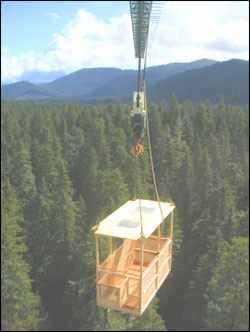Biometeorology and Micrometeorology

The gondola at the Wind River Canopy Crane Reasearch Facility, used to carry researchers into the canopy.
The Biometeorology and Micrometeorology program at Davis is concerned with the physical processes that govern exchanges between biological surfaces and the lower atmosphere. Such exchanges include momentum, sensible heat and water vapor, and various gases and particulate matter for both individual organisms and communities. Students in this specialty participate in modeling, observation and theoretical studies of these exchanges, with special emphasis upon the turbulent nature of the atmospheric surface layer.
Select a faculty member's name below to visit their web page.
Brian Bailey
The Bailey Lab is working to develop the next generation of high-performance computational tools that enable improved analysis and prediction of plant biophysical processes. We combine novel experimental and modeling approaches to conduct basic and applied research in plant productivity, water-use efficiency, microclimate, and micrometeorology. The lab is particularly interested in better understanding how plant structure and function impacts biophysical processes across scales.
Ian Faloona
Professor Faloona works to bridge the traditional fields of geophysical turbulence and chemistry with emphasis placed on an interdisciplinary understanding of the physical and chemical principles that control trace gas concentrations and their fluctuations in the atmosphere and ocean. The turbulent planetary boundary layers that lie adjacent to the interfaces of the earth, ocean, and sky play host to a great variety of exchange processes that are critical to understanding the climate system. Scientific investigation into such processes is undertaken by Professor Faloona's group on aircraft, ocean vessels, towers, and in the lab using a wide array of optical and mass spectrometric analytical techniques. The ultimate objective is to use the data to learn about both chemical reactions rates and the meteorological mixing processes, which strongly control the ability of compounds to react with one another. His group pursues research topics in atmospheric and oceanic photochemistry, boundary layer and mesoscale meteorology, and biogeochemical trace gas fluxes.
Adele Igel
Professor Adele Igel’s research is focused on understanding the microphysical processes that occur in clouds and how they 1) are impacted by atmospheric aerosols and pollution, 2) feedback to cloud dynamics, and 3) influence daily weather and climate. The clouds studied by Professor Adele Igel include everything from small shallow cumulus clouds found in the boundary layer, to deep convective clouds on the mesoscale and extratropical cyclones on the synoptic scale. Better understanding of cloud microphysics is crucial to improving global climate models and has been identified by the IPCC as one of the leading sources of uncertainty in predictions of future climate. Professor Adele Igel is working both on developing improved representations of clouds in models and on understanding how clouds and aerosols impact the weather and climate.
Yufang Jin
Professor Yufang Jin’s research focuses on the interactions between climate, ecosystem, wildfire disturbance, and management practices. She uses primarily satellite and airborne remote sensing observations, in combination with field measurements and biogeochemical modeling, to study the processes and feedbacks associated with ecosystem dynamics. Her studies cover diverse ecosystems, ranging from croplands, rangelands, savannas, to forests, and focusing particularly on landscape- and regional-scale phenomena. The primary goal is to develop improved eco-hydrological monitoring capabilities and provide data-driven information support for precision agriculture, natural resource management, mitigation and adaptation strategies.
Kyaw Tha Paw U
Professor Paw U studies the physical and biometeorological processes responsible for exchanges of momentum, heat, and gases such as water vapor between the lower atmosphere and vegetated surfaces. These processes are fundamental to understanding how forests, for example, absorb pollutant gases, how agricultural crops utilize water, and how plant communities exchange carbon dioxide with the atmosphere. The plant biometeorology research encompasses experimental observation in the field, numerical modeling, and theoretical analysis of turbulent mechanisms in and above plant communities. Experiments involve using fast response instruments to measure turbulence, such as sonic anemometers and infrared gas analyzers (IRGAs). Current projects include estimating turbulent parameters and dispersion coefficients for a California regional air quality study, and determining, by eddy-covariance and mean advection methods, and the carbon exchange between the atmosphere and a 500-year old, 65 m high forest at the Wind River Canopy Crane Research facility (WRCCRF). Our research group is measuring carbon dioxide fluxes, and is in collaboration with a group measuring biogenic hydrocarbon emissions from the forest canopy. Recent data indicated this old-growth forest is surprising active and is annually sequestering approximately 2 tons of carbon per hectare, similar to younger forests. Other areas of research focus on the observation and analysis of repeatable patterns in the turbulent wind fields. These characteristic motions, or coherent structures, appear to play an important role in the overall exchange process. Numerical modeling work involves two main topics, the first being state-of-the-art Large Eddy Simulation (LES) of turbulence within and above plan canopies, using the NCAR supercomputer system. The second topic is the numerical modeling of plant canopies using higher-order closure turbulence equations linked with radiation, energy budget, and plant physiology models. This set of models has been named the "Advanced Canopy-Atmosphere Simulation Algorithm" (ACASA). It has been connected to the regional scale model MM5 and can provide a regional scale understanding of ecosystem-atmosphere interactions of radiation, the energy balance, carbon, water, other gaseous and particulate emissions, transport, and deposition. In addition, Professor Paw U has studied the thermal budget of animals and humans in response to atmospheric variables.
Susan Ustin (Emeritus)
Professor Ustin is interested in the application of optical and microwave remote sensing techniques to estimate evapotranspiration and energy budget processes over a wide range of spatial and temporal scales using experimental and theoretical approaches. Her research focuses on the development and use of techniques for estimating physiological processes and plant community structure at the landscape scale. She has worked to develop improved methods of monitoring environmental pollutants and changes in climate at landscape and regional scales using aircraft and satellite sensors.

